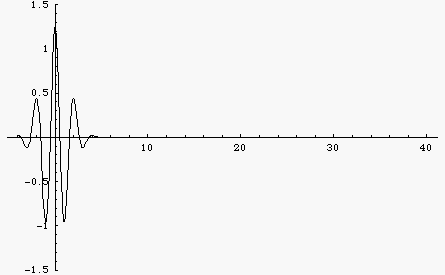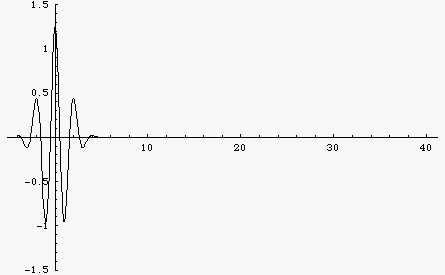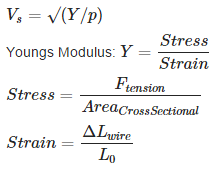Speed of Sound
The speed of sound is the distance traveled over time by a sound wave in an elastic medium. The SI unit of speed is meters per second or (m/s). The speed of sound in dry air at 20 ° C is 343.2 m/s. In different mediums (gas, solids, or liquids) the speed of sound is different than 343.2 m/s.
The Main Idea
The main idea of this topic is to determine the speed of sound in different mediums.
A Mathematical Model
The speed of sound, or c, is usually determined by the Newton-Laplace Equation, shown below. This equation shows the relationship between the stiffness of an object and it's density.
- c is the speed of sound
- Ks is the coefficient of stiffness
- ρ is the density
This equation shows that the speed of sound increases as the stiffness increases or the density of a material decreases.
The general equation for the speed of sound, using classical mechanics is given as:
- c is the speed of sound
- p is the pressure
- ρ is the density and the derivative at constant entropy s
Dependence on the Medium
A dispersive medium is a medium in which waves of different frequencies travel at different speeds and a non-dispersive medium is a medium in which the speed is independent of frequency. In non-dispersive mediums, the speed of sound is independent of sound frequency, while in dispersive mediums the speed of sound can vary greatly based on it's frequency.
Waves travelling through a non-dispersive medium, such as an ideal gas
Waves travelling through a dispersive medium, such as a metal bar
Solids
In solid objects, the speed of sound depends on the Young's Modulus and the density of the solid is known. Young's modulus is dependent on the stress and strain of the solid. Young's modulus replaces Ks in the Newton-Laplace equation.
- Vs is the speed of sound
- p is the density
- Y is Young's Modulus
For more information about the speed of sound in a solid see this Wiki page.
Fluids
In fluid mediums, the speed of sound only depends on the mediums compressibilty and density. This is because liquid cannot have a stiffness, meaning it cannot sustain shear forces. Therefore, the equation of the speed of sound in a liquid is as follows:
- cfluid is the speed of sound in fluids
- ρ is the density
- K is the bulk modulus of the fluid
Gases
Gaseous mediums can be both dispersive and non-dispersive. The speed of sound in gas is only dependent on density. This is because the heat capacity ratio relates compressibility to pressure, and the pressure and density of a gas are inversely related. For ideal gases, the speed of sound is only dependent on temperature. This is because the pressure and density of an ideal gas will cancel out at a constant temperature. However, in non-deal gases, the pressure of a gas does not cancel with density, so the pressure still has an effect on the speed of sound.
Sound will travel faster in lighter gases such as Helium than in heavier gases such as Xenon.
The Newton-Laplace equation can be rewritten with respect to the bulk modulus formula:
- c is the speed of sound
- γ is the adiabatic index (the ratio of specific heats of a gas at a constant pressure to gas at a constant volume)
- p is the pressure
- ρ is the density
A Computational Model WIP
How do we visualize or predict using this topic. Consider embedding some vpython code here Teach hands-on with GlowScript
Examples
Simple
What is the speed of sound in copper?
First, we know that we use the solids version of the Newton-Laplace equation. This means we replace stiffness with Young's Modulus. We can then list what we know:
- c is the speed of sound
- Young's Modulus is 117 GPa
- ρ is 8960 kg/m3
Therefore:
c = √(1.17e11 ⁄ 8960)
c = 3613.59 m/s
Middling
What is the speed of sound on Venus? Assume the atmosphere of Venus is 100% Carbon Dioxide.
First, we know that we use the gases version of the Newton-Laplace equation. This means we replace stiffness with γ and pressure. We can then list what we know:
- c is the speed of sound
- γ is 1.28
- p is 90 atmospheres, or 9.119e6 Pa
- ρ is 1.1842 kg/m3
Therefore:
c = √(1.28 (9.119e6 ⁄ 1.1842)
c = 2517.293 m/s
Difficult
How long does it take for someone at a depth of 1000 meters in the ocean to hear someone at the surface?
First, we know that we use the liquids version of the Newton-Laplace equation. This means we replace stiffness with the bulk modulus of the fluid. We can then list what we know:
- c is the speed of sound
- K is 2.34e9 Pa
- ρ is 1029 kg/m3
Therefore:
c = √(2.34e9 ⁄ 1029)
c = 1507.996 m/s
We then use the equation:
x/c = t
to determine how long it would take for the sound to travel. Let's list what we know.
- c is the speed of sound
- x is distance or 1000 m
- t is time
t = 1000/1507.996 m/s
t = .66313 seconds
Connectedness
The speed of sound is interesting because it isn't a constant, like light. Sound is also an observable phenomena which is why we were able to first determine the differences in the speed of sound between air and water. I used to stay underwater in a pool and listen to people above the water because it sounded cool. I also think it is interesting to observe the effect that different mediums have on sound- since sound is a wave, it is only observable by the effect it has on the surroundings.
As a Chemical Engineering major, I don't plan to do much work with sound, but I find the effects of changing the medium of sound interesting. The chemical composition of different solids or liquids can have an effect on their interactions with the outside world, which is something that a Chemical Engineer has to remain aware of when working with any products that may be industrialized.
If sound travels faster in certain solids, this information can be used to develop certain types of plastics or other cheap building materials that are also soundproof. On the other side of this, in terms of military development, soldiers or police may be in situations where they need to sharpen their hearing, so the development of an earpiece or headphones that can collect sound waves from solids rather than the air could be a breakthrough in recon assignments.
History
The first person to calculate the speed of sound was Sir Issac Newton in the latter half of the 17th century. Newton used only pressure and density in his original equation of the speed of sound. Later, but in the same century, Pierre-Simon Laplace added gamma, or a measure of pressure, to Newton's formula. Laplace set Ks to γ * pressure. This is called the Newton-Laplace formula and is still used today to determine the speed of sound in different materials.
See also
Are there related topics or categories in this wiki resource for the curious reader to explore? How does this topic fit into that context?
Further reading
Nature, Behavior, and Properties of Sound
External links
Speed of Sound in Air Calculator
References
Matter and Interactions






